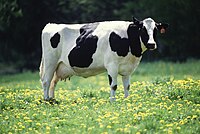
Photo from wikipedia
The objective of this study was to investigate the occurrence and distribution of methicillin-resistant Staphylococcus aureus (MRSA) on 20 German dairy farms. Farms were selected based on previous MRSA reports… Click to show full abstract
The objective of this study was to investigate the occurrence and distribution of methicillin-resistant Staphylococcus aureus (MRSA) on 20 German dairy farms. Farms were selected based on previous MRSA reports from phenotypic susceptibility testing of mastitis pathogens. Samples were collected from predefined groups of cows, young stock, farm personnel, and the environment. A high MRSA-positive test rate was detected in swab samples from milk-fed calves (22.7%; 46/203). In postweaning calves, the MRSA-positive test rate was 9.1% (17/187). From prefresh heifers, both nasal swabs and udder cleft swabs were collected if possible. Including both sample types, the MRSA-positive test rate in prefresh heifers was 13.0% (26/200). The positive test rate was 8.9% (17/191) in nasal swabs and 6.5% (11/170) in udder cleft swabs. In quarter milk samples (QMS), the MRSA-positive test rate was 2.9% (67/2347), and on cow level, 7.9% (47/597) of the dairy cows were affected. Among all cows included in this study, the geometric mean of somatic cell counts was higher in QMS that carried MRSA (345,000 cells/mL) in comparison to all QMS (114,000 cells/mL). No differences in parity or the affected mammary quarter position on the udder were observed among the 47 infected cows. Methicillin-resistant S. aureus was also detected in boot swab samples (dust), teat liners, and in suckers from automatic calf feeders. All isolates belonged to livestock-associated sequence type 398 and most common staphylococcal protein A (spa)-types were t011 and t034. Most isolates harbored the staphylococcal cassette chromosome mec (SCCmec)-type V, with the exception of some isolates with SCCmec-type IVa on 1 farm. Similar MRSA genotypes in samples from humans and dairy cows underline the possible zoonotic and reverse-zoonotic transmission of livestock-associated MRSA strains from dairy farms. Similar MRSA genotypes in pig and cattle barns were detected on only 1 of 5 farms that kept both cattle and pigs. Similar MRSA spa-types were detected in samples from different sources (dairy cows, young stock, environment, and humans), suggesting a possible contagious transmission on some of the farms. Sporadically, up to 3 different MRSA spa-types were detected in QMS from the respective farms. On MRSA-affected farms, improper milking hygiene procedures and elevated bulk-tank milk somatic cell counts (>250,000 cells/mL) were observed. The occurrence of livestock-associated MRSA ST398 in different samples from dairy farms, and especially in young calves, should be considered for future MRSA-monitoring programs and biosecurity guidelines.
Journal Title: Journal of dairy science
Year Published: 2020
Link to full text (if available)
Share on Social Media: Sign Up to like & get
recommendations!